► Seven-seat SUV driven in the UK
► Essentially a stretched CX-60
► Plug-in hybrid and diesel available
Mazda has a pretty good grip on the family SUV market these days, offering a smörgåsbord of options to cover most bases off, but the new CX-80 is the undoubtedly the flagship. It’s the biggest model in the range, with the most space inside and the capacity to carry seven people in comfort. The last Mazda with three rows that you could buy in the UK was the entirely forgettable and eponymously-named 5 MPV. Remember that? Neither do we.
This one is likely to make more of an impression. For a start, just look at it! With a low-slung (for an SUV) body, delicately-sculpted flanks, and cab-back proportions, it certainly looks different to the usual boxy fare. Arriving as Mazda’s new flagship, the CX-80 stacks up well on paper, but with a list of excellent rivals to face – the latest Skoda Kodiaq and new Hyundai Santa Fe being the two main ones – can the Mazda CX-80 do enough to stand out?
At a glance
Pros: Spacious layout, superb ergonomics, generous equipment levels
Cons: Unrefined hybrid motor, rival SUVs have bigger boots
What’s new?
If you think the CX-80 looks familiar, that’s because the front half is essentially the same as the Mazda CX-60, the Japanese firm’s European range-topper for the last couple of years which has opened the brand up to new customers and introduced Mazda’s first plug-in hybrid.
The CX-80 is essentially a stretched CX-60, with a longer wheelbase, a third row of seats and a new rear end, which isn’t exactly its finest angle – and that’s putting it kindly. It’s around 25cm longer and 3cm taller, while Mazda has also tweaked the suspension for more comfort – a bone of contention with the CX-60.

Mazda is predicting quite modest UK sales figures, but hopes (like the CX-60) to tempt buyers across from more premium brands. It lists the significantly more expensive Mercedes-Benz GLE and BMW X5 as rivals, as well as more mainstream competition such as the Kia Sorento, which has also had a recent refresh.
What are the specs?
Engine choice is largely the same as the CX-60, except the entry-level rear-wheel-drive diesel isn’t available in the CX-80 – as much as we love the idea of a RWD seven-seat SUV. As such, all models come with all-wheel-drive and an eight-speed automatic gearbox. There’s the option of a plug-in hybrid or Mazda’s clever straight-six diesel. Mazda initially promised a straight-six Skyactiv-X petrol engine but says changing market conditions mean it’s no longer on the table.
The plug-in will account for the vast majority of sales in the UK due to our tax concessions for long-range PHEVs, and pairs a 2.5-litre petrol engine with an electric motor for a combined 323bhp and 369lb ft of torque, enabling a 0-62mph time of 6.8 seconds. A 17.8kWh battery allows for a claimed electric range of 38 miles, similar to a Hyundai Santa Fe PHEV, but is almost half that of the impressive Skoda Kodiaq plug-in.
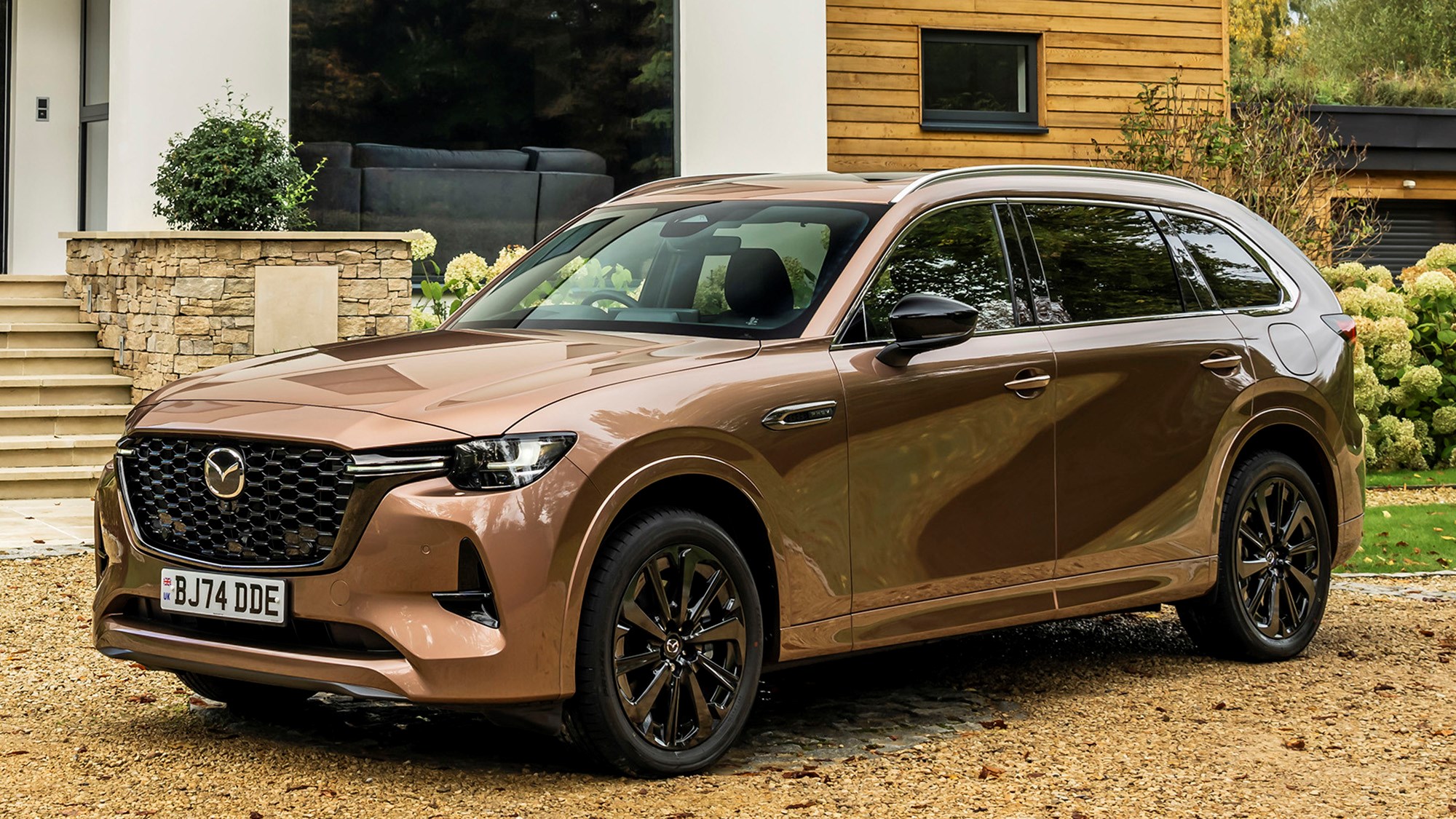
The only other engine is Mazda’s 3.3-litre straight-six mild-hybrid diesel engine first seen in the CX-60. The Japanese firm takes an unusual approach to engines and doesn’t believe in downsizing owing to a larger capacity engine’s better thermal efficiency. As a result, it’s almost twice the capacity of most rivals and a bit of a novelty these days, with derv no longer offered from South Korean rivals. The diesel will be limited in its audience, but Mazda believes it can poach buyers from rivals that are shunning diesels – even Volvo XC90 customers.
So the diesel puts out 251bhp and 406lb ft of torque, enabling a 0-60mph time of 8.4 seconds, with Mazda still claiming almost 50mpg. Figures like that should be achievable on a steady, longer run. Unusually, all CX-80s also have a 2.5-tonne towing capacity, with there being none of the usual penalties for the PHEV.
How does it drive?
Mazda has clearly worked hard to retune the unsettled suspension of the CX-60 on its new CX-80, and our first impressions are of a better ride. It doesn’t have the bounciness of its smaller sibling, feeling far more settled even on the punishing mix of pockmarked A- and B-roads on our usual test route. This is no doubt helped by the longer wheelbase, as well as the fact you won’t find a CX-80 riding on daft 22-inch alloy wheels. That said, it’s still not as supple as the Skoda Kodiaq, which feels more cushioned still.
As with the CX-60, the plug-in hybrid continues to let the side down. It’s surprisingly dim-witted for a PHEV, and you really need the car in Sport mode for it to seem anywhere near as fast as the figures suggest, and feels no faster than the diesel. The PHEV is also not refined in the slightest, and unlike rivals which hide the transition from electric motor to engine so well, in the CX-80 you’re always aware of the power source in operation.
It also makes random, disconcerting noises on occasion, with vibrations being felt under your feet if you endeavour to put your food down. Like on the CX-60, the diesel is the better car to drive, being more refined and smoother, while the small weight saving over the PHEV makes it slightly more nimble.
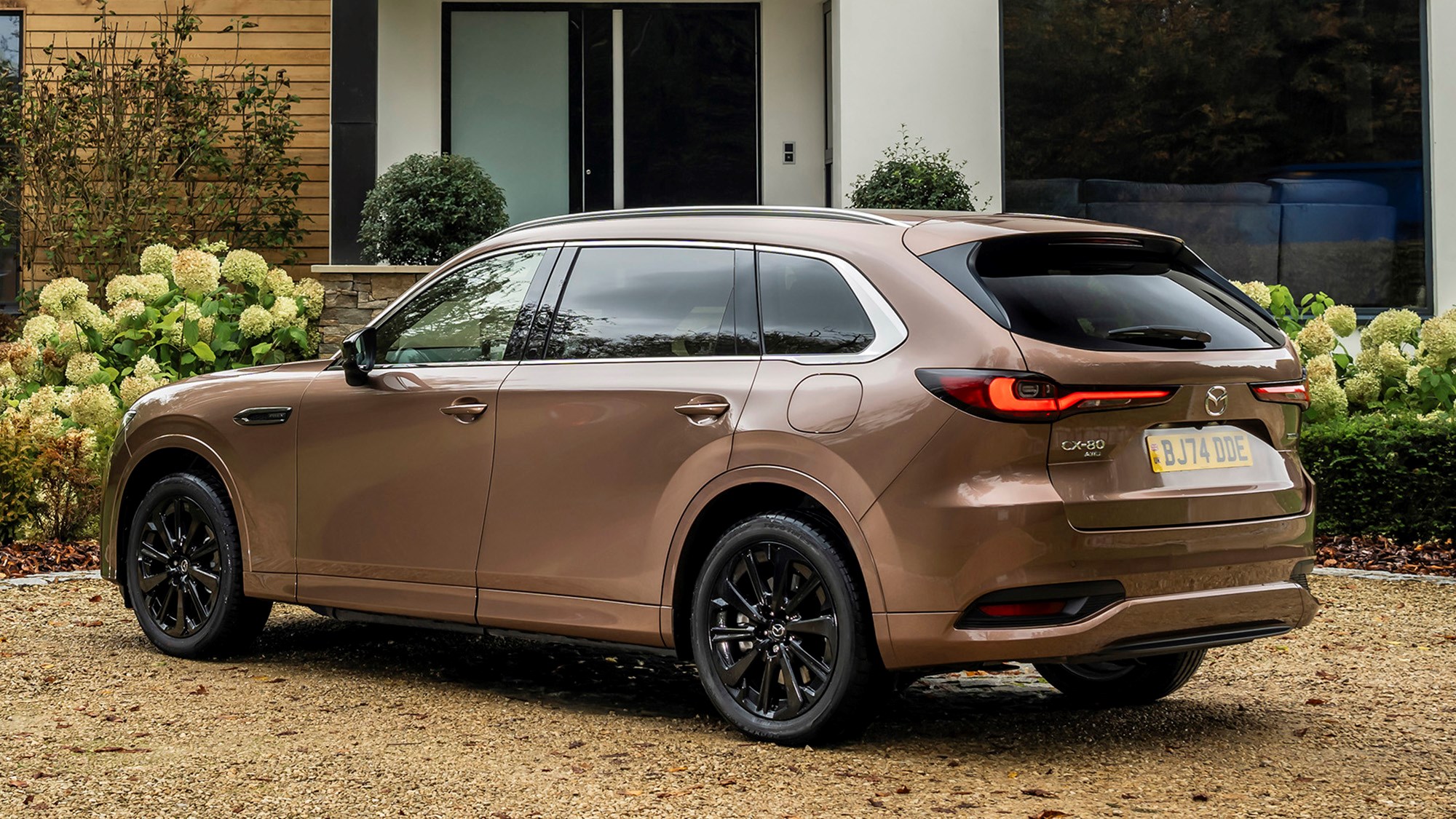
Mazda’s cars are well-regarded for the way they drive, and the CX-80 is no exception. The steering is particualrly well-weighted and accurate for a car of this class. Mazda hasn’t tried to hide the CX-80’s size or weight too much, with plenty of roll through th corners if you put your foot down. But it is well tied down, and does feel reasonably agile thanks to the quick steering – more than acceptable for a seven-seat SUV with no sporty preconceptions.
A tight turning circle and excellent all-round visibility are particualrly useful traits for car in this class, too. One of the few things I’d change is lower the seating position, which just feels too perched even by SUV standards.
What’s it like inside?
Mazda has put those extra dimensions in the CX-80 to good use and created a particularly spacious SUV. Unlike a Skoda Kodiaq, seven seats are standard across the line-up, with a six-seat configuration including two captain’s chairs in the middle row available as an option on Homura and Homura Plus models. As on the Kia EV9, which is available in a similar configuration, seven seats always make the most sense.
The centre row of seats provide ample room for taller adults, with only the panoramic sunroof and its intrusive sunblind potentially getting in the way of headroom. The second row also slide forward easily, enabling surprisingly easy access to the third row. Space back there is best for children but adults will be able to sit for a small journey without too much discomfort. Dedicated storage and USB-C sockets in the third row are useful additions as well.
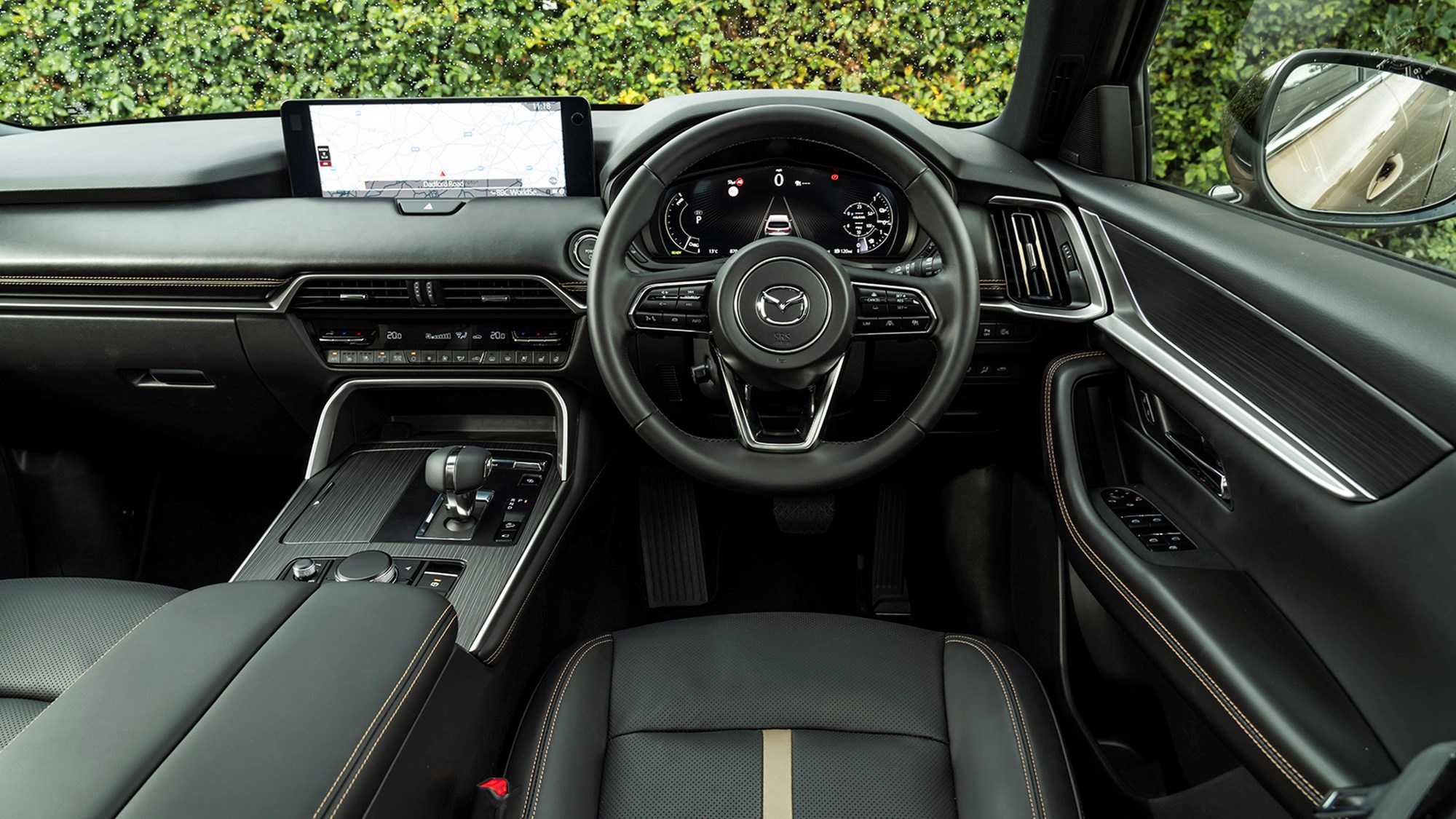
The CX-80’s boot floor is higher than that of rivals, though, and isn’t quite as useful as a Skoda Kodiaq’s, though unlike that, you’re still able to get the PHEV with seven seats. The weird shape of the rear end means that the boot itself doesn’t open very high, leaving potential for the taller few to bash their heads on it. Don’t ask me how I know…
Mazda does ergonomics well, too. If you’re not a fan of touchscreens being used for LITERALLY EVERYTHING you’ll probably like the CX-80’s cabin. The screen is purely operated by a rotary controller, rather reminiscent of BMW’s original i-Drive set-up, and with lots of additional physical switchgear – even for the climate control – it feels brilliantly analogue for a modern SUV.
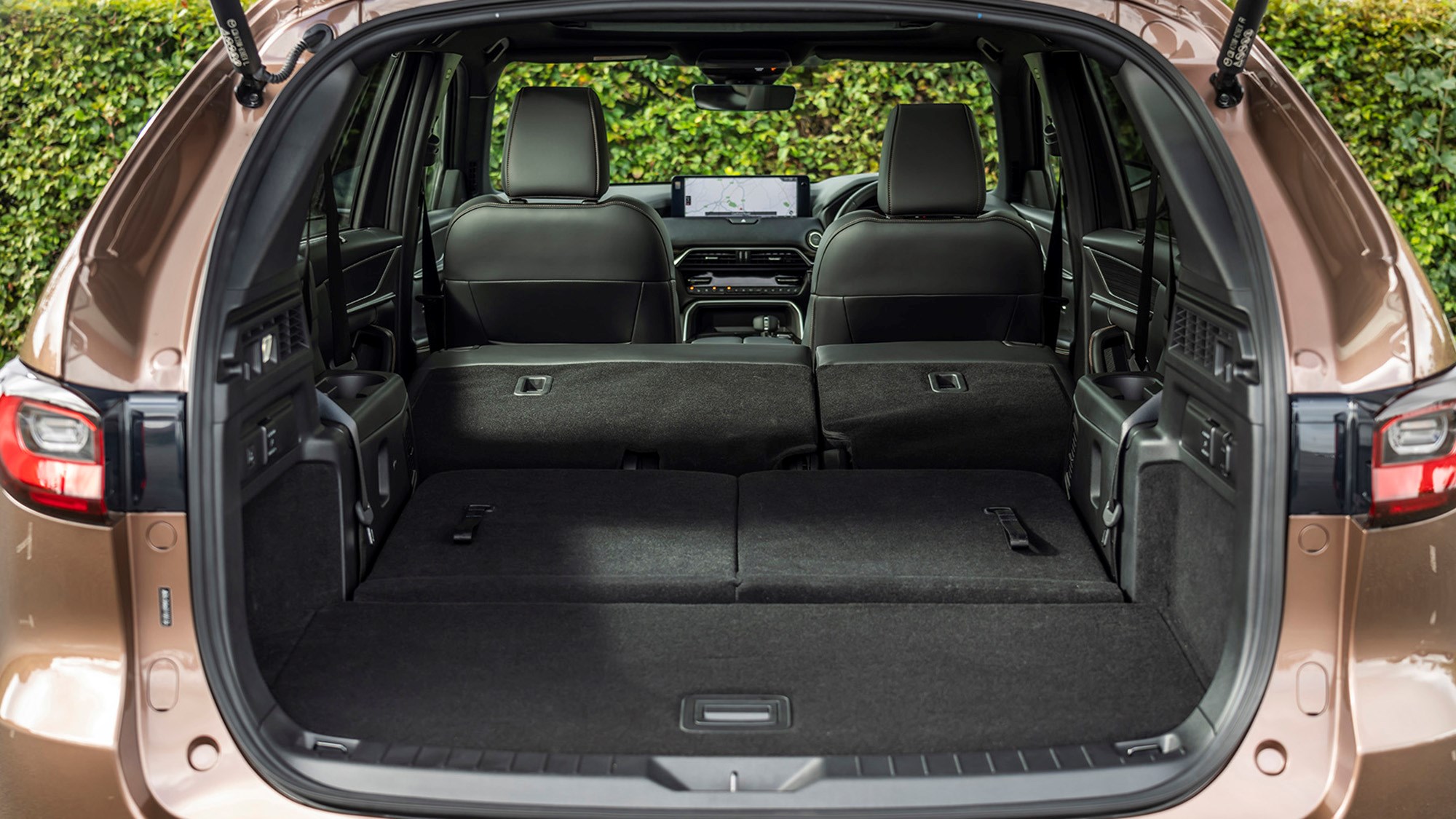
The displays aren’t quite as crisp or customisable as those in rivals, but that’s not a bad thing here. Build quality is excellent too, with good materials used throughout, and even into the second row. I must add I’m really not a fan of the white maple wood trim fitted to the top-spec Takumi models, which cheapens the cabin.
Before you buy
Prices for the CX-80 start from £48,920 for the PHEV and £51,455 for the diesel, making it Mazda’s most expensive car, and around £3,500 more than a CX-60. Providing you’ll use that third row at least occasionally, it justifies that extra expense.
There’s a pretty extensive line-up of five trim levels available, too. Even the entry-level Exclusive Line is well-equipped though, including an electric boot, heated leather seats, keyless entry and adaptive cruise control.
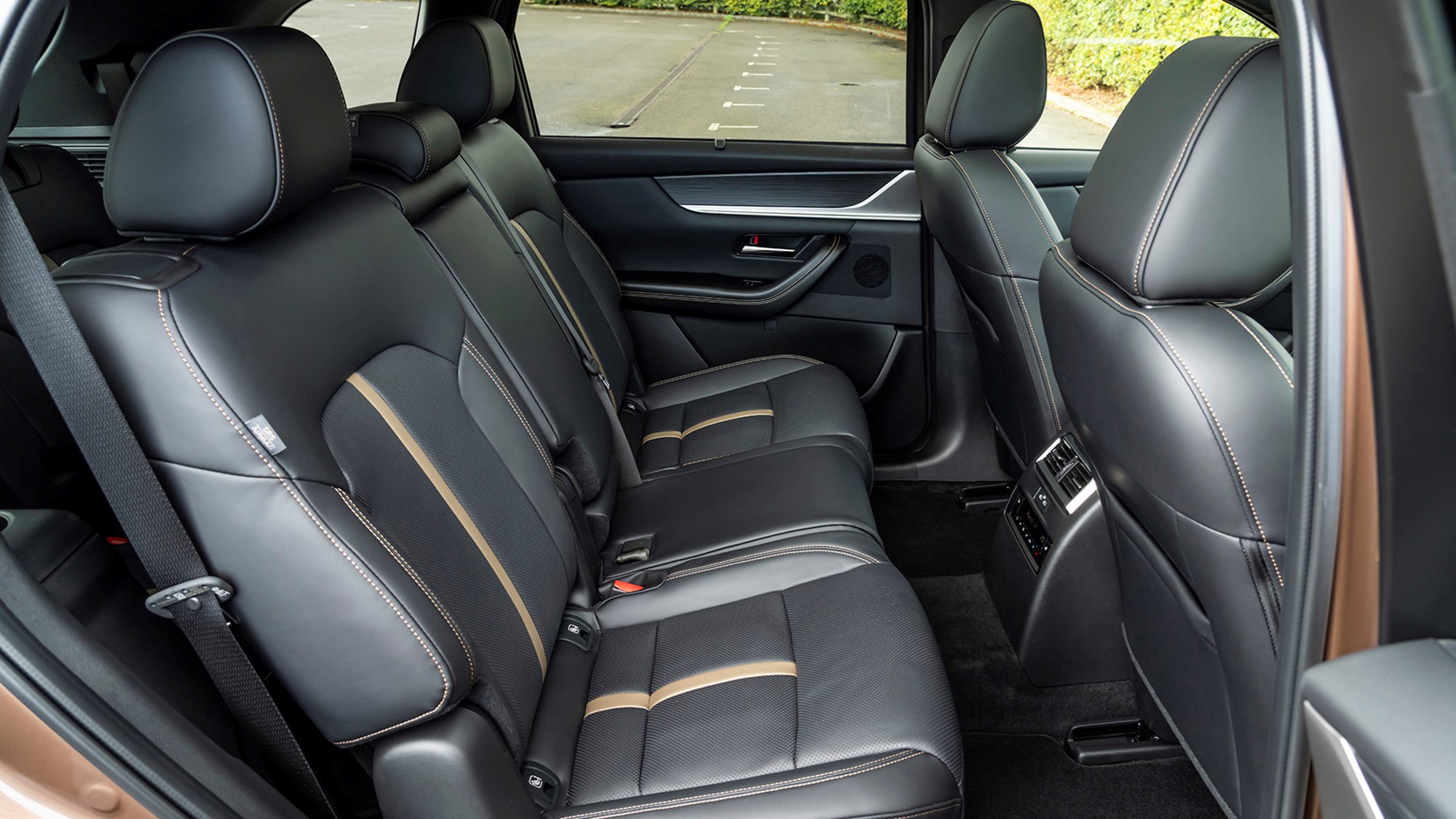
The Homura grade adds 20-inch black alloy wheels, a Bose sound system, electric steering wheel column and electric and ventilated front seats. Homura Plus then brings a panoramic sunroof and 360-degree camera system. The top-spec Takumi features white Nappa leather seats (probably not great if you have kids) and the aforementioned white wood trim.
While a Kodiaq starts from less money, it’s not quite as large a car as this Mazda, and when specced with all the extras the CX-80 comes with, there’s not too much price difference. A plug-in hybrid Hyundai Santa Fe starts from more money, too, though is undoubtedly much more impressive to look at.
Verdict
Mazda’s wide-ranging SUV line-up often brings overlap, and that was always the case for the CX-60. It offered little over a CX-5 yet cost considerably more money. But the new CX-80 is a welcome addition to its line-up, and its impressive interior flexibility makes it an excellent large family SUV. The third row of seats are slightly more usable than in core rivals, too.
The plug-in hybrid system is the only weak link, and if you really want a hybrid seven-seat SUV, we’d probably point you in the direction of a Skoda Kodiaq or Hyundai Santa Fe for their superior setups. But if you’re happy with a diesel, which is smooth and economical, the CX-80 is a talented large SUV that feels traditional in the best sort of way.